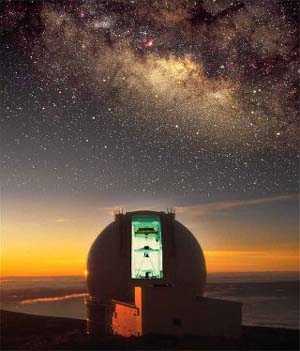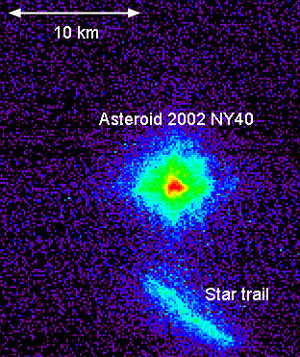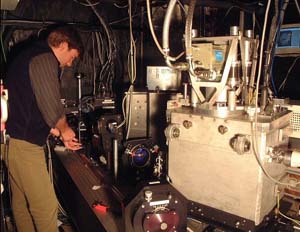On the night of August 18, 2002, a chunk of rock several hundred metres across flew past the Earth at a distance of 530,000 kilometres – just a little further into space than the Moon. At the time, the British media were still reeling from the possibility that another asteroid was destined to collide with Earth in the year 2019.
However, a more down to Earth appraisal by Chris Benn, Sebastian Els, Tom Gregory, Roy Ostensen and Francisco Prada using the William Herschel Telescope on La Palma, Canary Islands, of NY40 while it was at an altitude of 750,000 kilometres is helping astronomers get a better understanding of these interplanetary objects.

The WHT is the most powerful optical/infrared telescope in the world (Credit: Nik Szymanek and Ian King)
NY40 was travelling at 65,000 kilometres per hour during its near miss but despite this, very high-quality images were obtained in the near-infrared end of the spectrum with a resolution of 0.11 seconds of arc (about 1/33,000 of a degree). This resolution is close to the theoretical limit of the Herschel telescope and sets an upper limit to the size of the asteroid of a mere 400 metres across at the time of the observations. Several observers have reported variations in the brightness of 2002 NY40. This suggests that the rock is highly elongated and tumbling through space. Further work is required to determine its orientation during different observations and so obtain a more accurate estimate of size and shape.
Sizing up asteroids will help astronomers understand their nature and formation history as well as the potential threat they pose. There is a small population of Near Earth Asteroids (NEOs) whose journeys around the sun occasionally approach or intersect the orbit of our planet. A direct intersection in time and space is thought to have occurred 65 million years ago wiping out the dinosaurs.

H-band (1.63 microns) image of asteroid 2002 NY40 taken on the night of August 17 to 18, 2002. (Credit: The ING NAOMI team)
Fortunately, despite the media scare stories, the odds are stacked against an asteroid hitting the Earth in the near future. Close encounters with large Near Earth Asteroids, like 2002 NY40, do happen every fifty years or so. NEA 2001 CU11 passed just outside the Moon’s orbit on the 31st of August 1925 but it was not observed at the time. Indeed, it was not actually discovered until 77 years later.

The NAOMI Adaptive Optics system at the Nasmyth focus of the William Herschel Telescope (Credit: The NAOMI team)
NAOMI was created by researchers at the University of Durham and the UK Astronomy Technology Centre. It incorporates a system of fast-moving mirror elements, which correct in real-time for the defocusing of stars caused by the Earth’s turbulent atmosphere – it compensates for twinkling, in other words!
Further reading
Near Earth objects
http://neo.jpl.nasa.gov/news/
Deep impact!
http://www.space.com/scienceastronomy/planetearth/deep_impact_991228.html
NAOMI
http://www.roe.ac.uk/atc/projects/naomi/
UK Astronomy Technology Centre
http://www.roe.ac.uk/ukatc/
Suggested searches
Near Earth object
Asteroids